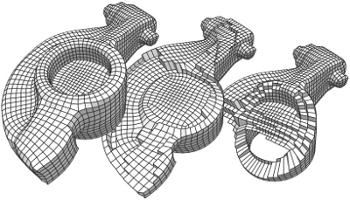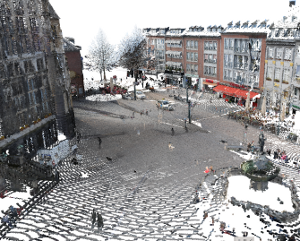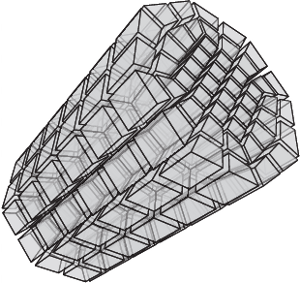Profile

|
Dipl. Inform. Michael Kremer |
Publications
Advanced Automatic Hexahedral Mesh Generation from Surface Quad Meshes

A purely topological approach for the generation of hexahedral meshes from quadrilateral surface meshes of genus zero has been proposed by M. Müller-Hannemann: in a first stage, the input surface mesh is reduced to a single hexahedron by successively eliminating loops from the dual graph of the quad mesh; in the second stage, the hexahedral mesh is constructed by extruding a layer of hexahedra for each dual loop from the first stage in reverse elimination order. In this paper, we introduce several techniques to extend the scope of target shapes of the approach and significantly improve the quality of the generated hexahedral meshes. While the original method can only handle "almost convex" objects and requires mesh surgery and remeshing in case of concave geometry, we propose a method to overcome this issue by introducing the notion of concave dual loops. Furthermore, we analyze and improve the heuristic to determine the elimination order for the dual loops such that the inordinate introduction of interior singular edges, i.e. edges of degree other than four in the hexahedral mesh, can be avoided in many cases.
OpenFlipper - A Highly Modular Framework for Processing and Visualization of Complex Geometric Models

OpenFlipper is an open-source framework for processing and visualization of complex geometric models suitable for software development in both research and commercial applications. In this paper we describe in detail the software architecture which is designed in order to provide a high degree of modularity and adaptability for various purposes. Although OpenFlipper originates in the field of geometry processing, many emerging applications in this domain increasingly rely on immersion technologies. Consequently, the presented software is, unlike most existing VR software frameworks, mainly intended to be used for the content creation and processing of virtual environments while directly providing a variety of immersion techniques. By keeping OpenFlipper’s core as simple as possible and implementing functional components as plugins, the framework’s structure allows for easy extensions, replacements, and bundling. We particularly focus on the description of the integrated rendering pipeline that addresses the requirements of flexible, modern high-end graphics applications. Furthermore we describe how cross-platform unit and smoke testing as well as continuous integration is implemented in order to guarantee that new code revisions remain portable and regression is minimized. OpenFlipper is licensed under the Lesser GNU Public License and available, up to this state, for Linux, Windows, and Mac OSX.
OpenVolumeMesh - A Versatile Index-Based Data Structure for 3D Polytopal Complexes

OpenVolumeMesh is a data structure which is able to represent heterogeneous 3-dimensional polytopal cell complexes and is general enough to also represent non- manifolds without incurring undue overhead. Extending the idea of half-edge based data structures for two-manifold surface meshes, all faces, i.e. the two-dimensional entities of a mesh, are represented by a pair of oriented half-faces. The concept of using directed half-entities enables inducing an orientation to the meshes in an intuitive and easy to use manner. We pursue the idea of encoding connectivity by storing first-order top-down incidence relations per entity, i.e. for each entity of dimension d, a list of links to the respective incident entities of dimension d?1 is stored. For instance, each half-face as well as its orientation is uniquely determined by a tuple of links to its incident half- edges or each 3D cell by the set of incident half-faces. This representation allows for handling non-manifolds as well as mixed-dimensional mesh configurations. No entity is duplicated according to its valence, instead, it is shared by all incident entities in order to reduce memory consumption. Furthermore, an array-based storage layout is used in combination with direct index-based access. This guarantees constant access time to the entities of a mesh. Although bottom-up incidence relations are implied by the top-down incidences, our data structure provides the option to explicitly generate and cache them in a transparent manner. This allows for accelerated navigation in the local neighbor- hood of an entity. We provide an open-source and platform-independent implementation of the proposed data structure written in C++ using dynamic typing paradigms. The li- brary is equipped with a set of STL compliant iterators, a generic property system to dynamically attach properties to all entities at run-time, and a serializer/deseri- alizer supporting a simple file format. Due to its similarity to the OpenMesh data structure, it is easy to use, in particular for those familiar with OpenMesh. Since the presented data structure is compact, intuitive, and efficient, it is suitable for a variety of applications, such as meshing, visualization, and numerical analysis. OpenVolumeMesh is open-source software licensed under the terms of the LGPL.

